Pharmacy U presenter Wayne Caverly: Avoid cookie-cutter solutions for your pharmacy automation
Wayne Caverly will be presenting at Pharmacy U Vancouver.
In my 32 years' designing and automating pharmacies I’ve gotten these questions many times. “I fill 300 Rx/day. Should I get a counting machine”? “I fill 400 Rx/day. What size dispensary do I need”?
I’d love to give an easy answer, but unfortunately “every pharmacy is a snowflake.”
There are simply too many variables:
- 300 Rx a day doesn’t tell us much. Are these all vial? Is it 100 vial, 100 blister and 100 reconstitutions and compounds? Do you do a lot of unit-of-use dispensing? Each has its own storage and production space needs.
- What is your pharmacy pharmacist to tech ratio? The more you rely on pharmacists to help with production, the more valuable technology becomes. And your design will be affected by who is doing the final verification.
- Is your practice model traditional or “pharmacist first”? In our traditional model the patients are greeted by a technician and then they sit and wait, or leave and return later. In the pharmacist-first model each patient is greeted by a pharmacist and most sit with that pharmacist while their prescriptions are being filled. The pharmacist-first method requires more physical space and demands faster prescription production.
- What technologies are in use? Every technology you consider takes physical space that must be properly planned for optimal workflow.
- What is your new-to-refill ratio? New obviously take longer to process, which may lead to multiple data entry points, each requiring sufficient space.
- How many, and what type of professional services do you offer? You may need only one semi-private and one private counsel room, or you may need multiples of each. If you sell products that must be tried on you may need a fitting room. All of these add to the space required and most have specific wheelchair requirements.
People love to publish rules of thumb, especially when they’re trying to sell something and they want an easy sell sheet. Technology companies do it all the time: 50-150 Rx/day = product A; 151-250 = product B. Same problem. In the right hands these of course are just guidelines. The salesperson would ask many more questions than what the Rx volume is, and then steer you to the right product(s).
I always tell people about two clients I had in the ‘90s while with BakerAPS (precursor of McKesson Automation) who were both using the original Baker Cells tablet/capsule counting system. Both were located in Edmonton. The first was a tiny place that serviced a poor and troubled area. Their scripts came mostly from less than a dozen physicians. This client’s top 23 products represented almost 80 per cent of his oral solid business. Across town was the Woodwards department store with a pharmacy in the basement. This pharmacy received prescriptions from physicians from all over the city. Their 48 top products represented less than 40 per cent of their oral solid business. Think also of a pharmacy across the street from a children’s hospital: a lot less oral solids and a lot more reconstitutions and compounds than your average pharmacy…or one within or near senior’s residences: mostly blister cards or pouches.
I think we’re fortunate that every pharmacy is a snowflake, and to properly design or automate one you have to dig a lot deeper than how many Rxs they fill. This is a good thing because some diligent work by a knowledgeable consultant will ensure you get exactly what you need to answer your current needs and future goals.
Wayne Caverly is president of the Caverly Consulting Group. He is also an internationally recognized speaker and published author with more than 40 articles on pharmacy automation and design who has contributed to two pharmacy textbooks. He has more than 25 years’ experience automating, designing, and reengineering community pharmacies.

